You can kill bed bugs instantly by spraying them directly with 70% rubbing alcohol, which breaks down their protective outer shell and causes rapid dehydration. Fill a spray bottle with isopropyl alcohol and target visible bugs on mattress seams, bed frames, and furniture joints while ensuring proper ventilation. However, alcohol only works through direct contact and won’t affect hidden bugs or eggs. Combining alcohol treatment with heat and vacuuming creates a more thorough approach to total elimination.
How Rubbing Alcohol Kills Bed Bugs on Contact
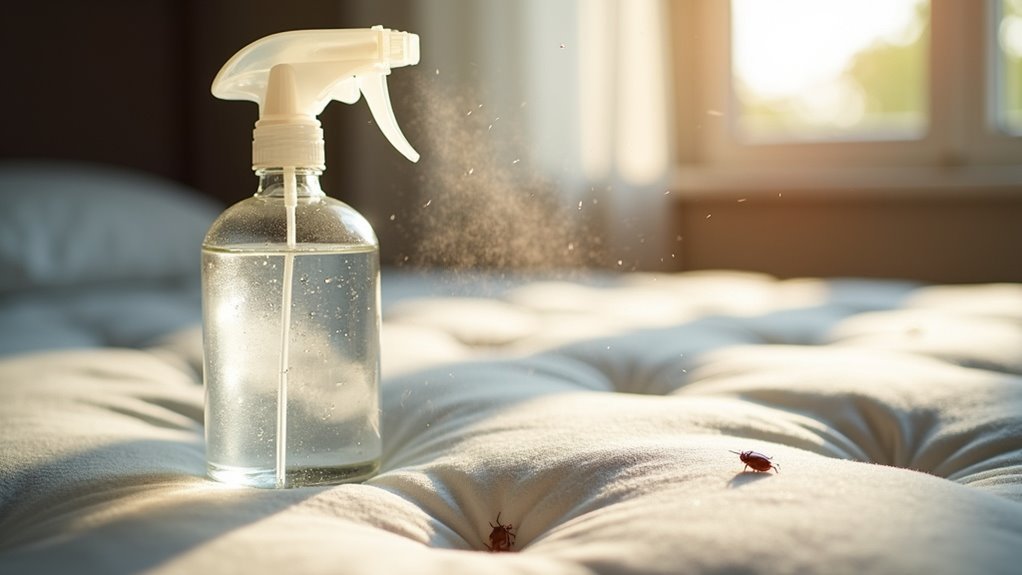
Rubbing alcohol attacks bed bugs by breaking down their protective outer shell and rapidly dehydrating their bodies when it makes direct contact. This process dissolves their exoskeletons, causing immediate death upon contact.
Rubbing alcohol destroys bed bugs on contact by dissolving their exoskeletons and rapidly dehydrating their bodies.
You’ll want to use 70% concentration for best results, as this strength provides better penetration into the bug’s body. Higher concentrations evaporate too quickly before they can kill bed bugs effectively.
While rubbing alcohol serves as an effective method for eliminating visible bed bugs, it only works through direct contact. Once the alcohol dries, it loses all killing power and won’t affect any bugs that enter the treated area later.
Remember the flammable nature of rubbing alcohol requires careful handling around fabrics and heat sources to prevent fire hazards.
Best Alcohol Concentration for Maximum Effectiveness
You’ll find that 70% isopropyl alcohol outperforms higher concentrations like 91% when targeting bed bugs.
While 91% alcohol might seem stronger, it evaporates too quickly to maintain effective contact time with the insects.
The 70% concentration strikes the perfect balance between penetration power and staying power, giving it enough time to dehydrate bed bugs on contact.
70% Vs 91% Comparison
When choosing between 70% and 91% isopropyl alcohol concentrations, you’ll find that 91% delivers markedly superior killing power against bed bugs.
The effectiveness difference is substantial – 91% alcohol can kill bed bugs on contact within 30 seconds, while 70% rubbing alcohol shows less than 50% effectiveness compared to the higher concentration.
Here’s how 91% alcohol outperforms 70%:
- Penetration depth – reaches bugs hiding in fabric crevices and mattress seams
- Toxicity level – higher concentration means faster nervous system shutdown
- Immediate impact – adult and nymph bed bugs die within seconds of direct contact
- Hard-to-reach areas – better coverage in tight spaces where bugs congregate
However, 91% alcohol does evaporate faster, potentially reducing prolonged exposure time.
Higher Concentrations Evaporate Quickly
Despite 91% alcohol’s superior killing power, this concentration presents a critical drawback that can undermine your bed bug treatment efforts. Higher concentrations of rubbing alcohol evaporate quickly, drastically reducing contact time with bed bugs.
When you spray 91% or 99% alcohol, it disappears within seconds, preventing the prolonged exposure needed to kill these resilient pests effectively. This rapid evaporation means you’re getting less bang for your buck. The alcohol needs sustained contact to penetrate bed bug exoskeletons and disrupt their cellular functions.
When it evaporates too quickly, surviving bugs can recover and continue reproducing. Additionally, higher concentrations create increased safety risks due to enhanced flammability. The faster evaporation rate fills your room with alcohol vapors more rapidly, creating potentially dangerous conditions.
For maximum effectiveness and safety, stick with 70% concentrations.
Optimal Penetration Rate
Seventy percent isopropyl alcohol strikes the perfect balance between killing power and contact time, making it the gold standard for bed bug elimination.
This ideal concentration guarantees rubbing alcohol doesn’t evaporate before penetrating the bug’s exoskeleton, maximizing your chances of success through direct contact.
The effectiveness of 70% alcohol comes from its ability to:
- Dissolve protective waxy coatings on bed bug exoskeletons
- Maintain surface wetness long enough for complete dehydration
- Penetrate deeper into bug tissues than higher concentrations
- Kill approximately 50% of bed bugs upon direct spraying
When you spray bed bugs with this ideal concentration, the alcohol remains active longer, giving it time to break down their defenses.
Higher concentrations simply evaporate too quickly, reducing their killing potential considerably.
Step-by-Step Application Method for Alcohol Treatment
Four essential steps guarantee your alcohol treatment effectively eliminates bed bugs on contact.
First, fill your spray bottle with 70% rubbing alcohol for maximum effectiveness. Open windows and doors to increase ventilation before starting application.
Fill spray bottles with 70% rubbing alcohol and ensure proper ventilation by opening windows and doors before beginning treatment.
Second, target visible bed bugs and their hiding spots including mattress seams, bed frames, and furniture crevices. You must verify direct contact between the rubbing alcohol and insects for the treatment to kill bed bugs successfully.
Third, spray thoroughly but avoid oversaturating upholstered surfaces due to flammability risks. The alcohol must touch the bugs directly to be effective against bed bugs.
Finally, vacuum dead insects after the alcohol dries and wipe treated surfaces clean to remove any remaining residue.
Safety Precautions When Using Flammable Alcohol Sprays
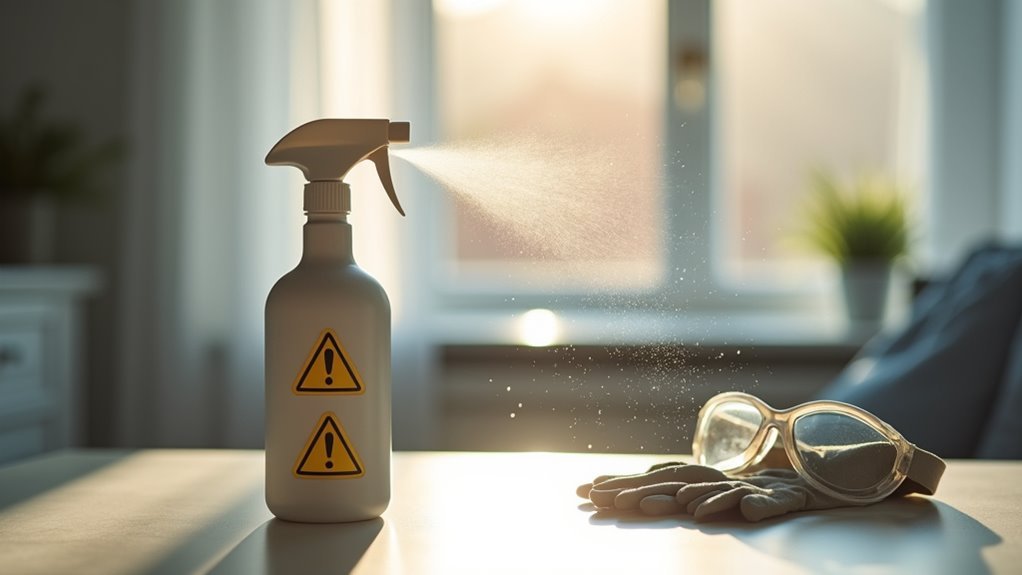
While alcohol spray proves effective against bed bugs, you must take serious safety measures when handling this highly flammable substance.
These safety precautions can prevent dangerous accidents and protect your health.
Follow these essential guidelines:
- Ensure proper ventilation – Open all windows and doors before spraying to prevent harmful fume buildup in enclosed spaces.
- Wear protective gloves and goggles – Shield your skin and eyes from direct contact with the alcohol solution.
- Keep away from heat sources – Never spray near open flames, candles, or electrical appliances that could ignite the flammable vapors.
- Follow EPA guidelines – Remove pets and people from treated areas until surfaces are completely dry and well-ventilated before allowing re-entry.
Why Alcohol Only Works on Visible Bed Bugs
You’ll find that alcohol spray only eliminates bed bugs through direct contact, which means it can’t reach the hidden insects lurking in cracks, crevices, and other inaccessible areas throughout your home.
The bugs you can’t see will survive the treatment and continue reproducing, as alcohol doesn’t penetrate deep into their hiding spots or provide any lasting protection once it evaporates.
This contact-only killing mechanism explains why you’re likely seeing bed bugs return shortly after treatment, since the majority of the population remains safely tucked away from your spray.
Contact Kill Mechanism
Alcohol spray delivers a fatal blow to bed bugs through direct contact, triggering rapid dehydration that destroys their cellular structure within minutes. When you spray rubbing alcohol directly onto bed bugs, the desiccation process begins immediately, causing their bodies to lose essential moisture.
However, this contact kill mechanism has significant limitations:
- You must see the target – Hidden bed bugs in wall cracks escape unharmed.
- Your spray evaporates quickly – No residual effect remains after application.
- You can’t penetrate protective surfaces – Bed bug eggs resist alcohol’s killing power.
- You’ll miss clustered insects – Back rows survive while front bugs die.
This mechanism explains why rubbing alcohol can kill bed bugs you directly hit but won’t eliminate entire infestations lurking throughout your home.
Hidden Bug Survival
The hunt for bed bugs becomes a frustrating game of hide-and-seek when you rely on alcohol spray as your weapon.
You’ll find that rubbing alcohol only works when you can actually see and directly spray the bugs.
The real problem lies with bed bugs hiding in mattress seams, furniture cracks, and tiny crevices where your spray can’t reach.
These hidden populations remain completely safe from your alcohol treatment, making it ineffective against the majority of the infestation.
While you might kill bed bugs almost immediately upon contact, countless others survive in their concealed locations.
They’ll simply wait until the alcohol evaporates, then emerge to recolonize the treated areas, leaving you back where you started with a persistent infestation.
No Residual Protection
Within minutes of application, rubbing alcohol evaporates completely from surfaces, leaving zero residual protection against bed bugs. While it kills on contact when directly applied, you’re left vulnerable once it dries.
This creates a significant problem:
- Fresh arrivals survive – New bed bugs entering treated areas won’t be affected.
- Survivors emerge safely – Hidden bugs can venture out after evaporation without danger.
- Eggs remain protected – Unhatched eggs develop normally in previously treated spots.
- Reinfestation accelerates – Without ongoing protection, populations quickly rebuild.
Unlike professional pesticides that maintain effectiveness for weeks, rubbing alcohol offers only momentary control.
You’ll need repeated applications whenever bed bugs appear, making it an exhausting cycle rather than a lasting solution for infestations.
Limitations of Alcohol Against Bed Bug Eggs
While alcohol can kill adult bed bugs on contact, it fails miserably against their eggs due to a tough protective shell that prevents penetration.
This protective barrier makes alcohol completely ineffective against bed bug eggs, creating serious limitations in your treatment efforts. Since alcohol requires direct contact to work and evaporates quickly, it can’t reach eggs hidden deep in crevices where they’re typically laid.
Studies show that bed bug eggs maintain high survival rates when exposed to alcohol because they’re resistant to its desiccating effects.
Without eliminating these eggs, you’ll face inevitable reinfestation as they hatch into new generations of bed bugs, making alcohol spray an incomplete solution for thorough bed bug control.
Areas to Target When Spraying Alcohol for Bed Bugs
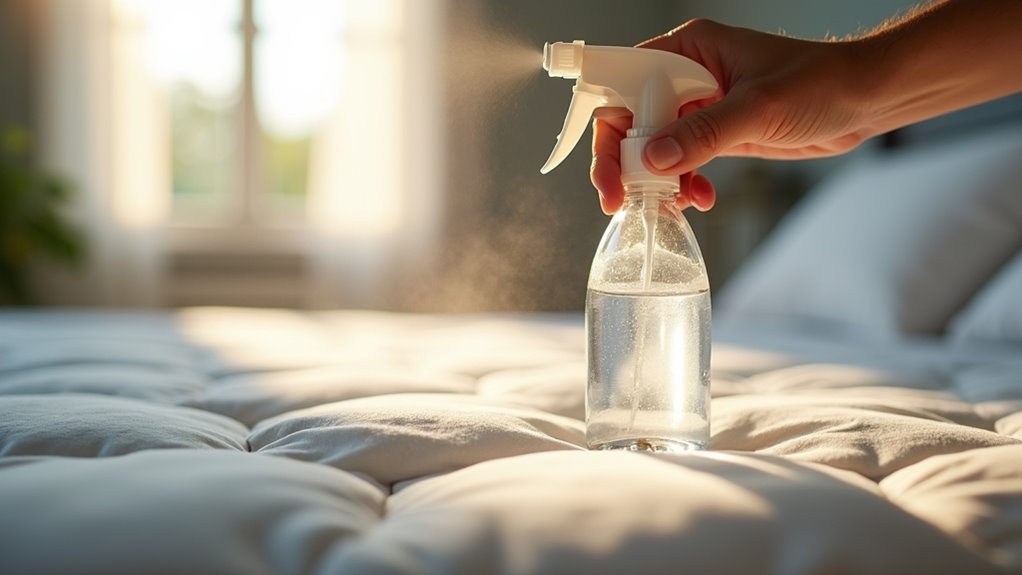
When you’re ready to spray alcohol on bed bugs, you’ll need to target their most common hiding spots for maximum effectiveness.
Focus your efforts on mattress seams, box spring edges, and furniture joints where these pests typically cluster during daylight hours.
Don’t overlook the tiny cracks and crevices in baseboards, bed frames, and wall junctions where bed bugs often establish their hidden colonies.
Common Hiding Spots
Since bed bugs are master hiders that retreat to dark, tight spaces during daylight hours, you’ll need to target specific areas where they’re most likely to establish their colonies.
These hiding places require thorough alcohol spray treatment to eliminate infestations effectively.
Focus your spraying efforts on these key locations:
- Mattresses and box springs – Pay special attention to seams, folds, and labels where bed bugs cluster.
- Upholstered furniture – Target joints, cushion crevices, and fabric folds in chairs and sofas.
- Cracks and crevices – Spray baseboards, wall gaps, and furniture joints where bugs squeeze into tight spaces.
- Electronics and nightstands – Treat areas around alarm clocks, chargers, and bedside furniture while avoiding moisture damage.
Mattress and Furniture
Because mattresses and furniture provide the perfect environment for bed bug colonies, you’ll need to systematically spray every potential hiding spot with focused precision.
Focus on seams, folds, and edges of your mattress and box spring where these pests typically congregate. Spray alcohol directly into furniture cracks or crevices, ensuring complete coverage of hard-to-reach areas.
Target bed frames, headboards, and wooden surfaces where you spot visible bugs, but exercise caution due to flammability risks.
The alcohol kills bed bugs on direct contact, making thorough application essential. After treating infested items, vacuum dead bugs immediately and wipe all surfaces clean.
Remember that alcohol won’t penetrate deep enough to eliminate hidden eggs, so you’ll need additional extensive treatment methods for complete eradication.
Cracks and Crevices
Cracks and crevices serve as bed bugs’ preferred hideouts, making these narrow spaces your primary targets during alcohol spray treatments.
You’ll need to apply directly into these areas to achieve maximum contact with hiding bed bugs, since alcohol only kills through direct application.
Focus your spraying efforts on these specific locations:
- Mattress seams and folds where fabric creates natural hiding spaces
- Bed frame joints and corners that provide dark, narrow shelters
- Baseboards and electrical outlets offering concealed breeding grounds
- Furniture crevices and upholstery gaps creating perfect bug sanctuaries
Don’t forget areas under furniture where bed bugs frequently establish colonies.
You must inspect and treat these cracks and crevices regularly, as survivors can quickly repopulate if your pest management approach isn’t thorough enough to eliminate every hiding spot.
Combining Alcohol Treatment With Heat and Vacuuming
While alcohol spray can effectively kill bed bugs on contact, you’ll achieve far better results when you combine it with heat treatment and thorough vacuuming. This integrated pest management approach maximizes your chances of complete elimination.
Start by vacuuming infested areas to remove visible bed bugs and eggs from surfaces. This reduces the population your alcohol treatment needs to target.
Begin with thorough vacuuming to physically remove bed bugs and eggs, significantly reducing the population before applying alcohol treatment.
Next, apply alcohol spray to commonly infested spots like mattress seams, headboards, and furniture joints to kill any remaining visible bugs.
Finally, use heat treatment through hot water washing or steam application. Heat penetrates deeper into materials and kills all life stages of bed bugs, including those hiding where alcohol can’t reach.
This three-pronged strategy overcomes each method’s individual limitations for thorough eradication.
Signs Your Alcohol Treatment Is Working
The most immediate indicator that your alcohol treatment is working is the rapid death of bed bugs within 30 seconds of direct contact with the spray.
Watch for these promising signs that alcohol kills bed bugs effectively:
- Instant kills – Visible bed bugs drop dead immediately upon contact with your alcohol spray.
- Declining sightings – You’ll notice fewer live bugs during daily inspections of mattress seams and furniture crevices.
- Dead bug discovery – Finding deceased bed bugs after vacuuming or wiping surfaces confirms successful elimination.
- Increased scattering – Temporary spikes in bed bug activity indicate they’re fleeing treated areas.
Regular monitoring of common hiding spots should reveal fewer signs of bed bugs over time, demonstrating your treatment’s ability to reduce infestation levels effectively.
When Professional Extermination Becomes Necessary
Although alcohol spray can kill individual bed bugs on contact, certain situations demand professional intervention to achieve complete eradication.
You’ll need professional help when your bed bug infestation covers multiple rooms or when DIY methods repeatedly fail to provide lasting results.
Professional bed bug exterminators possess specialized equipment like thermal cameras and heat treatments that reach hidden populations you can’t access.
Bed bugs develop resistance to common pesticides quickly, making professional-grade products essential for severe infestations.
If you’ve attempted multiple DIY methods without success, it’s time to contact exterminators who use integrated pest management strategies.
Professional bed bug services combine chemical treatments, heat applications, and thorough inspections to eliminate both visible bugs and their hidden eggs completely.
Frequently Asked Questions
Does Alcohol Kill Bed Bugs Instantly?
Alcohol doesn’t kill bed bugs instantly, but it’s very fast. You’ll see adult and nymph bed bugs die within 30 seconds of direct contact with rubbing alcohol spray applications.
What Spray Kills Bed Bugs Instantly?
You’ll find that 70% rubbing alcohol spray kills bed bugs instantly on contact within 30 seconds. However, it won’t eliminate eggs or hidden bugs, and it doesn’t provide lasting protection once dried.
Can I Spray Isopropyl Alcohol on a Sofa to Get Rid of Bed Bugs?
You can spray 70% isopropyl alcohol on your sofa to kill visible bed bugs on contact, but it won’t reach hidden bugs and creates fire hazards on upholstered furniture.
How to Use Alcohol Spray for Bed Bugs?
You’ll need 70% isopropyl alcohol in a spray bottle. Open windows for ventilation, then directly spray visible bugs and mattress seams. Wait thirty seconds, then vacuum dead bugs after drying completely.
In Summary
You’ve learned that alcohol spray can eliminate visible bed bugs on contact, but it’s not a complete solution. You’ll need 70-91% isopropyl alcohol and must target mattress seams, furniture cracks, and baseboards while following safety protocols. Remember, alcohol won’t reach hidden bugs or eggs, so you’ll want to combine it with heat treatment and vacuuming. If you’re still seeing bugs after multiple treatments, it’s time to call professional exterminators.

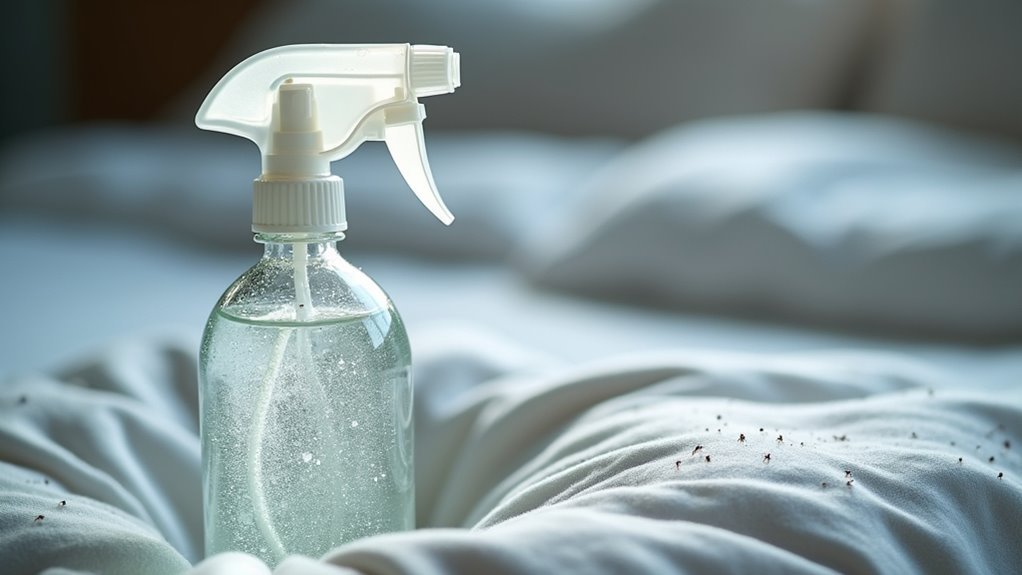
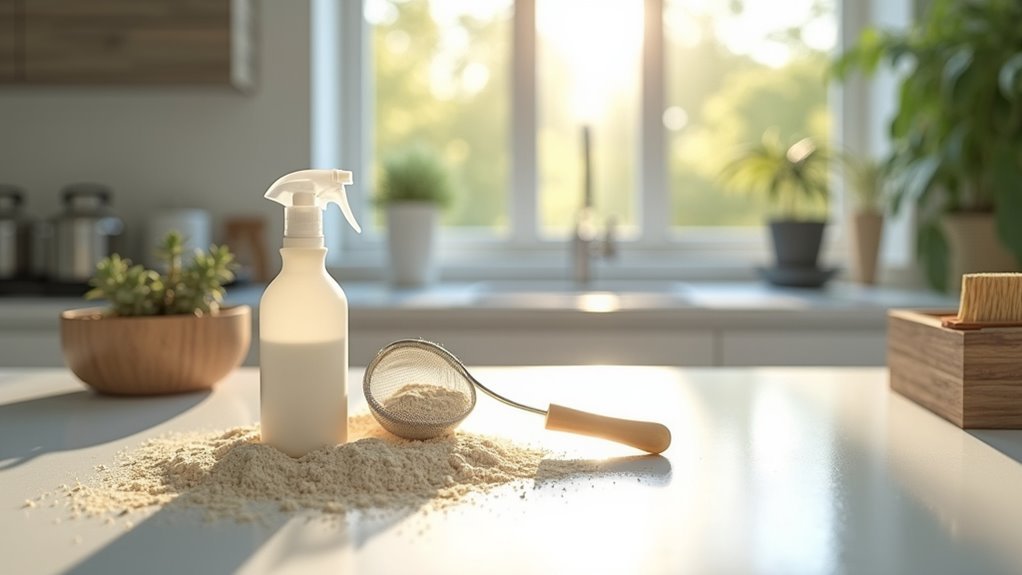
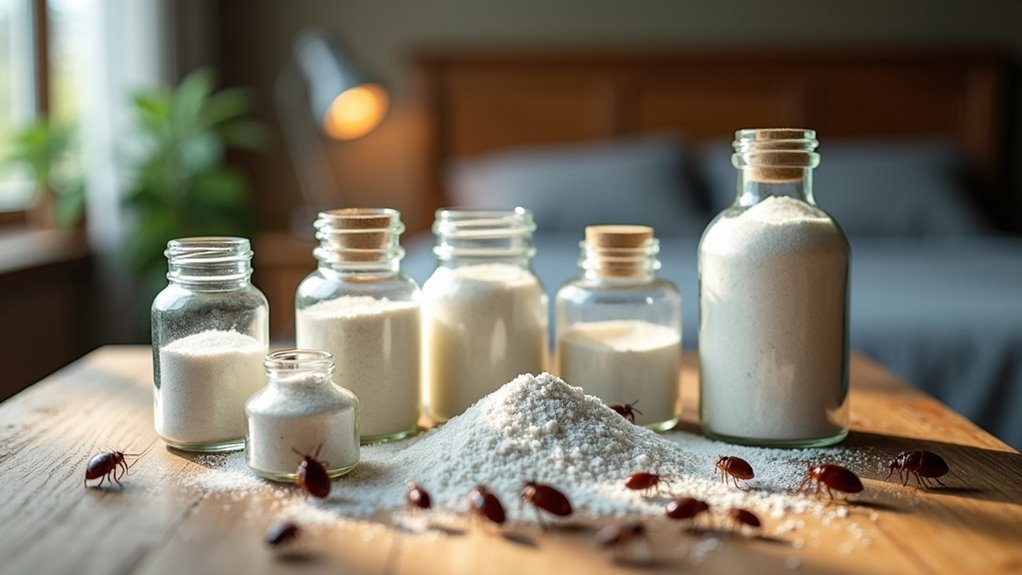
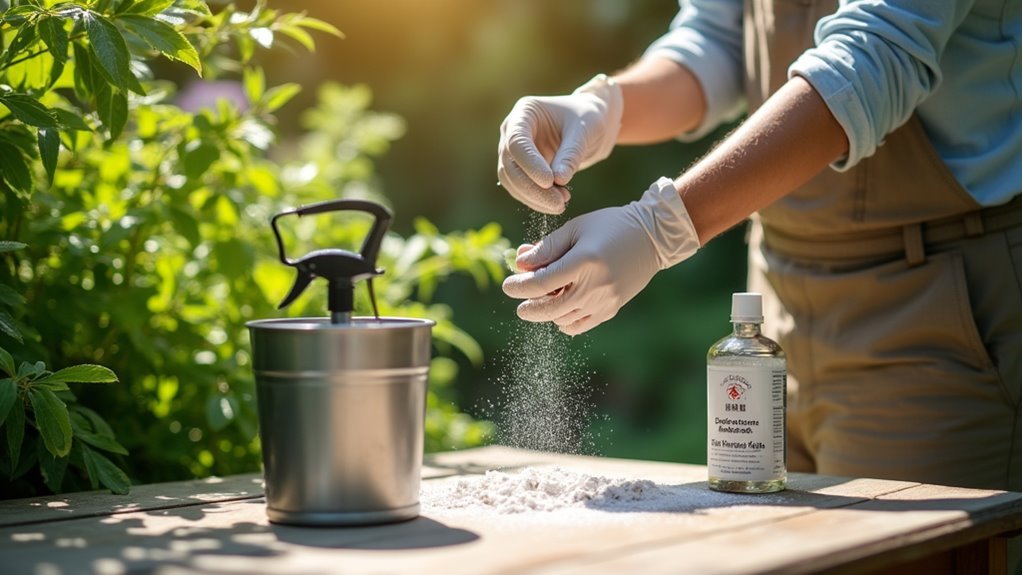
Leave a Reply